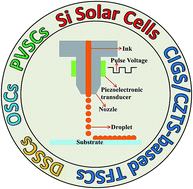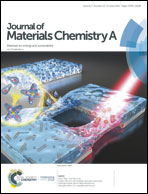Recent progress in inkjet-printed solar cells
Abstract
In the past few decades, the fabrication of solar cells has been considered as one of the most promising ways to meet the increasing energy demands to support the development of modern society as well as to control the environmental pollution caused by the combustion of fossil fuels. A number of different types of solar cells, such as silicon solar cells (Si), Cu-based chalcogenides (Cu(In,Ga)Se2/Cu2ZnSn(S,Se)4) thin film solar cells (TFSC), dye-sensitized solar cells (DSSC), organic solar cells (OSC), and perovskite solar cells (PVSC), have been implemented in the photovoltaic technology. However, the high manufacturing costs of solar cells is one of the major obstacles for their wide-scale application. In this regard, inkjet printing has attracted tremendous interest in both academic research and industrial applications among all the various kinds of fabrication techniques and is believed to be one of the most promising methods to meet these requirements. The great advantages of inkjet printing are that the process is contactless, maskless and has a high material utilization rate, and good scalability, and compatibility of the roll-to-roll process. Additionally, the maskless nature of inkjet printing allows for freedom of design, which enables multi-functional properties of solar cells (i.e., power source and artwork) to be realized. In this review, the recent advances in inkjet printing with the deposition of different layers of various types of solar cells are summarized in detail and prospectives for the future development of printed/flexible solar cells are covered.

- This article is part of the themed collection: Recent Review Articles


 Please wait while we load your content...
Please wait while we load your content...